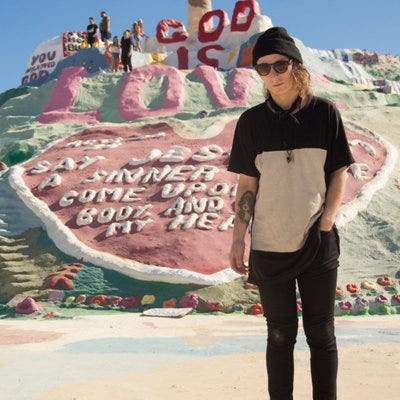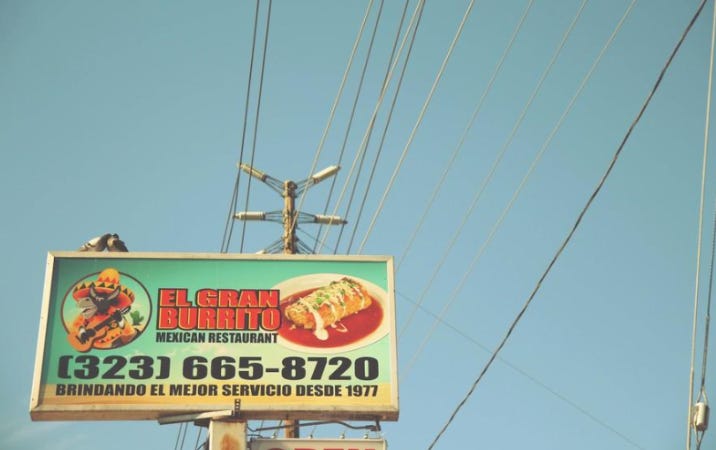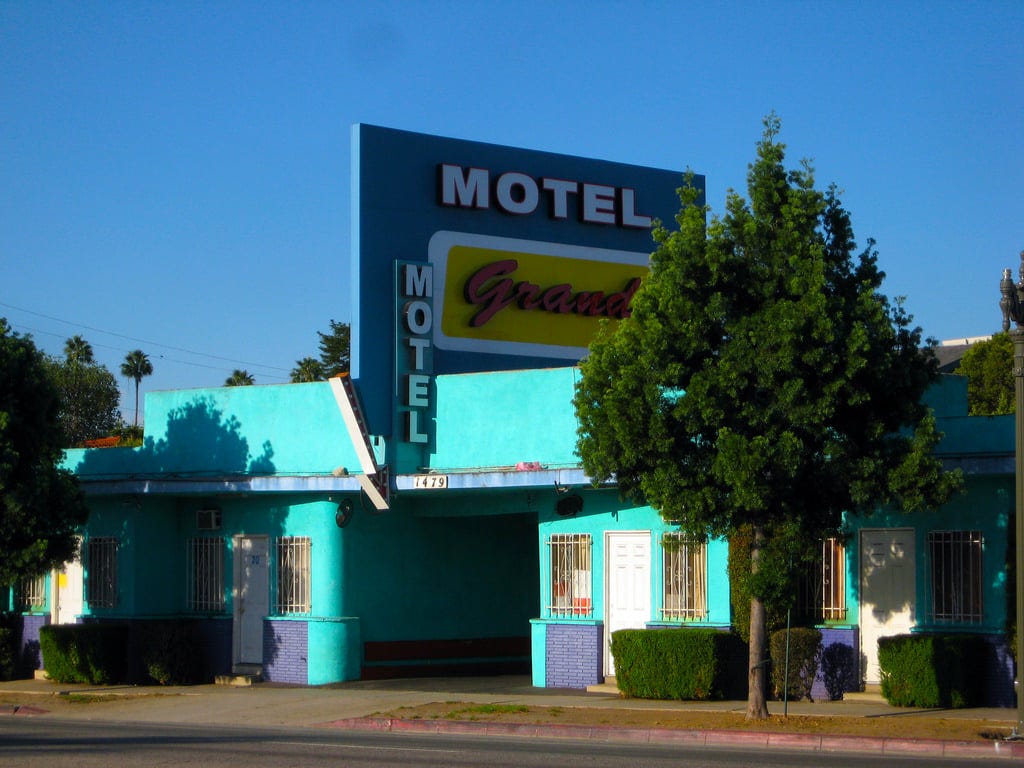Hello readers. As I gear up to begin a new “season” of Take Surface Streets, I’m publishing the newsletter’s nascent beginning, although I didn’t know it would be at the time. I wrote this article for a now defunct magazine and it has been lost to the sands of time (broken URLs and lapsed domains).
I’ve edited it a bit and made some pertinent updates in the footnotes. All of the photographs (unless otherwise noted) were taken by my friend and colleague, Benjamin Parker Karris, who died four years ago this month. He was immensely talented and kind. Carry Narcan.
Welcome to Santa Monica and Highland—the nexus of one of Hollywood’s largest prostitution tracks for more than 30 years, and the setting for Sean Baker’s Tangerine, a stark, mesmerizing film exploring the friendship between two trans sex workers during one manic, unraveling Christmas Eve.
Goes the adage: nobody walks in L.A. Or so says Missing Persons, as well as a certain socioeconomic set ever since. But as the narrator in Thom Andersen’s Los Angeles Plays Itself states, that’s just not true:
Who knows the city? Only those who walk. Only those who ride the bus. Forget the mystical blatherings of Joan Didion and company about the automobile and the freeways. They say, ‘nobody walks.’ They mean, ‘no rich white people like us walk.’
Baker’s Tangerine is a walking film. It's also an astonishingly, geographically congruous depiction of a bright, Angeleno December day—primarily through the eyes of those who walk. Sin Dee (Kitana Kiki Rodriguez) and Alexandra (Mya Taylor) are walkers. The mile radius surrounding Santa Monica and Highland, their community, is full of people who walk.
Take a stroll with us down Tangerine's Santa Monica, with a bit of the famed boulevard’s sex work history. It's a little different than the plucky subject of Sheryl Crow's "All I Wanna Do." (I was once told that the narrator of the song is telling the story from the Formosa. There once was a car wash across the street but…I’m not sure it really fits the vibe. If anyone knows Sheryl please ask her, thanks!)
In the ‘80s the area’s workforce began to shift gender. “For years, it was the female prostitution trade flourishing along Hollywood and Sunset boulevards,” writes Josh Meyer in a Los Angeles Times article from 1990, titled, “The Boys of the Boulevard.” “But now, Hollywood vice officers say, male prostitution has become a far worse blight.”
The year that article was published, photographer Philip-Lorca diCorcia began documenting male sex workers in the same area. One of my favorite portraits from the series, which would later be published in a book called Hustlers, is of a young man sitting across the street from Donut Time, a landmark of the seedier community in the area and a major location in Tangerine. The only thing that’s different about the intersection today is that the Del Taco has been replaced with a Walgreens.1

And as the community’s makeup changed from female to male, the number of trans prostitutes also rose. In 2004, Los Angeles Magazine reported on Hollywood’s vice squad, interviewing Vivianna Hernandez, a trans woman and victim advocate for the L.A. Gay and Lesbian Center who came to Hollywood in 1970. Hernandez says that in the '70s, prostitution was kept in the clubs along Cahuenga and Ivar. But not for long:
After the Hollywood vice squad worked to close down those establishments, L.A.’s transgender community broke apart. “It shifted to different places in the ‘70s,” says Hernandez. “It moved to Studio City, to a club on 6th and Main downtown called the Waldorf.” Then, in the early ‘80s, the community regrouped, landing in the neighborhood surrounding Santa Monica Boulevard.
This would be a hard-kept statistic, as many reports would file these sex workers into categories “male” or much more derogatory. Even as recent as 2013, the Los Angeles Times blundered its way through the reporting of Cassidy Vickers’ murder, a trans sex worker who frequented the Santa Monica Boulevard area. She was last seen alive at Donut Time.
It’s a rough gem, and an anchor of the local sex worker community. It’s where Tangerine opens and, plot wise, climaxes. The rest of the film bubbles outward from here:
Moving east down Santa Monica one block, at McCadden Place, is a strip mall housing Studio Liquor, Crown of India, and a typically grimy pawnshop. This is the parking lot where Sin Dee susses out a name, and where Alexandra will later tussle with a john.
They continue in the same direction to ask Nash about Chester’s whereabouts, meeting him at his office, El Gran Burrito.2
Which sits beside the Vermont-Santa Monica Red Line station. For those who walk in L.A., this is the opening to a major vein, bubbling with a chaotic energy most hours of the day.
Briefly, the geography changes as the film makes a locational leap (standard movie magic but rare for this film). Sin Dee marches to a rundown motel to yank Dinah from a drug-fueled in-call session, and continues yanking a single-flip-flopped Dinah across Hollywood.
It’s the Grand Motel3, which could be the “bargain-priced room on La Cienega” from the Mountain Goats’ “You or Your Memory,” if John Darnielle didn’t divulge that he actually checked into the Royal Hawaiian (about a mile east, on Venice and La Brea).4
The location was also used for the David LaChapelle directed video for Amy Winehouse’s “Tears Dry On Their Own.”
The Grand Motel was such a hotbed for drug deals and sex work that in 2016 the city attorney’s office asked the court to order its owner to live there himself until conditions improved, according to the L.A. Times.5
After a stop at Hamburger Mary’s for Alexandra’s dark, beautiful rendition of “Toyland” (the interior is actually The Cork Lounge in Sherman Oaks), the girls visit Donut Time again to finally confront Chester, and to watch Razmik’s family unearth his secret life. After this emotional firestorm quiets, the film ends softly—two blocks down Santa Monica at Las Palmas—in the Launderland Coin Laundry.
Thanks for Taking Surface Streets with me. Regular programming resumes next month.
No longer true. Donut Time no longer exists. It’s still a donut shop but now it’s painted pink and owned by actor Danny Trejo.
El Gran Burrito closed after 30s years in 2020.
It is now painted white. Not sure if operating.
Confirmed by Darnielle on 8/26/23 via DM, “Hotel was the Royal Hawaiian in the Pico-Crenshaw district, La Cienega fits better in the line than ‘in the Pico-Crenshaw district.’”
No idea if this ever came to fruition. Seems unlikely.












The lyrics are mostly based on a poem by Wyn Cooper https://web.archive.org/web/20010831182855/http://ahsahtapress.boisestate.edu/books/cooper.htm